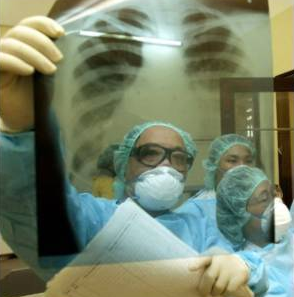 |
| Illustration of Lung Cancer Research |
Newer chemotherapy drugs, known by brandnames for example Navelbine®, Taxol®, Taxotere®, Gemzar®, Hycamtin®, and Camptosar® have produced improved response rates in tests of drug alone. Various mixtures of the brand new drugs with traditional agents, by way of example cisplatin and carboplatin, are either in clinical trials or have reported early link between the trials. Other researchers work to build up drugs called "molecularly targeted agents" which kill cancer cells by targeting key molecules thinking about cancer cell growth. Some of those drugs, called Avastin™, helped patients live a few months longer when it ended up in conjunction with traditional chemotherapy.
New approaches to schedule and deliver actinotherapy these are under study, too. In conformal radiotherapy, doctors try and measure the tumor in 3 dimensions while keeping your focus the beam of radiation entirely on areas from your tumor.
With brachytherapy doctors can deliver radiation straight to the tumor using radioactive pellets which are inserted into the site within the tumor. These techniques conformal radiotherapy and brachytherapy develop the reap the benefits of reducing problems for surrounding tissue. Researchers are constantly planning to produce new methods to find and diagnose carcinoma with the lung as a way to catch it and address it in the earliest stages. Stomach x-ray is definitely in regards to the most common tools employed to test for carcinoma of the lung.
However, just one single third of carcinoma of the lung cases detected by chest x-ray are only early enough to be cured. A study from a National Cancer Institute's Prostate, Lung, Colorectal, and Ovarian (PLCO) Cancer Screening Trial found that chest x-rays can detect early carcinoma on the lung, and can produce many false-good results. Meaning that this tests will show that someone could have cancer, whenever they really do not. Follow-up tests are essential to look at if someone really has cancer.
One screening method that shows promise is spiral computerized tomography, called spiral CT. Spiral CT can scan the lungs in the neck towards the diaphragm inside of 20 seconds, or maybe a single breath-hold. Research shows it can help doctors find small tumors, but questions stop in regards on the technology's risk and benefits being a screening tool.
Cancer of the lung prevention is the one other area that researchers are considering. One possible treatment there're studying is chemoprevention -- using natural or man-made drugs to reverse, suppress, or prevent cancer growth. Chemoprevention is usually an subject of active clinical research, that's research involving direct observation of patients. Additionally , you can find clinical trials under path to finding out how well some substances can figure to stop yet another, secondary form of cancer in patients who have had early-stage cancer of the lung.
An aerosol spray to supply drugs to the lungs and also a vaccine for nicotine addiction are one of the treatments researchers are studying. Common using these treatments could be years away, however. Many other agents which researchers hoped might prevent carcinoma of the lung included 13-cis retinoic acid or CRA or isotretinoin, and retinyl palmitate. Both of them are made out of a vitamin, but both have been seen to become ineffective.
No comments:
Post a Comment